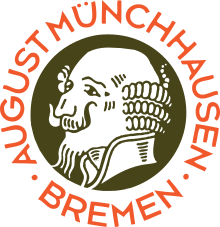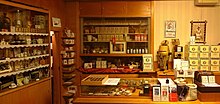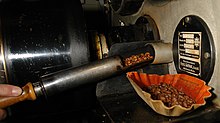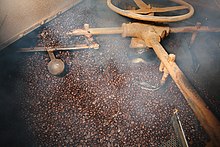August Münchhausen coffee roastery
The August Münchhausen coffee roastery has been in existence since 1935. From what were once more than 500 coffee roasters in Bremen , with many old details, it has been preserved almost unchanged as the oldest traditional family-owned roastery.
history

In Europe, coffee only became known to a wider audience in the second half of the 17th century. It was Dutch who imported it and also brought it to Bremen. The city was considered a coffee city early on, both in terms of the extent of trade and roasting as well as the extent of coffee enjoyment. Since 1673 "coffee-giving" has been mentioned in Bremen. One of the first cafés was built in 1697 in the cellar of the Schütting house .
In 1935 August Münchhausen founded the mail order business "Münchhausen Kaffee" for coffee and tea on the Teerhof . Just three years later, he acquired Geeren No. 24 - still the company's headquarters today - and installed a roasting system there . At the beginning of the Second World War , the stocks were confiscated and assigned to the Wehrmacht and "war-important" facilities. The production had to be switched to substitute coffee . After repeated air raids on Bremen, the roasting plant was relocated to Twistringen in 1941, where a coffee surrogate was mixed from chicory , sugar beet chips and crushed grain . Because of the well-known properties of its famous namesake Hieronymus von Münchhausen , the product was soon called "Münchhausen's Lies Coffee" by customers.
During the bombing in August 1944, the company located between the port and Weser bridges in Bremen's Stephaniviertel was completely destroyed; only the surrounding walls of the house remained.
New beginning after the war
After his return from French captivity, Münchhausen rebuilt the house in the Geeren. When green coffee could be freely imported after the currency reform in 1948, he also started up the roasting plant. The roasting book lists coffee from Kenya , Costa Rica , Guatemala , Colombia , and Santos and Minas in Brazil for January 1951 . Later came Timor , Tanganyika and Java added, from 1952 additionally Ecuador and Cameroon .
The (especially earlier) relatively high import tariffs made coffee a valuable commodity. In order not to have to pay customs for entire deliveries in advance, roasters set up their own customs warehouses , from which they can take the green coffee and pay tax on it as required. Because of the high price, small quantities were also offered for sale. At Münchhausen, these were initially 50-pfennig bags with a content of twelve grams, later on bags of 75 pfennigs with a price-dependent filling quantity.
"Piccolo" coffee machine
An automat developed by August Münchhausen in 1950 released five grams of freshly ground coffee. This "small canteen Piccolo" was set up free of charge in train stations, post offices and factory and company canteens and was looked after by representatives on a daily basis. After inserting a penny, enough coffee for a cup of the hot drink fell into the grinder, which can now be operated by hand. A water heater was supplied free of charge for the hot water if required. Around 1000 machines had been installed by the end of the 1950s. When modern hot drinks machines took their place in the early 1960s, Münchhausen withdrew from this business - instant coffee was not his thing.
Concentration thanks to the roaster giants
The focus in the 1960s on a few dominant large roasters with sales channels via supermarkets and extensive chain stores made coffee a mass commodity. Many roasters and mail order companies had to give way to this competitive pressure. At the beginning of the 1960s, Münchhausen took over the small coffee roasters Friedrich Ahldag, Lorentz and JFG Kadelbach Nfg. With their customer base, but could not stop the negative development for his company. By individually mixing and refining high-quality highland coffees that are not available in the required quantities for large roasters, the family business has retained a market niche to this day. Around fourteen tons of coffee are processed annually - exactly according to the specifications of the company founder.
August Münchhausen roasted himself until shortly before his death, making him “Germany's oldest active roasting master”. He died in 2003 at the age of 92. Since then, his daughter, the mathematician Ilse Münchhausen-Prüße, has been running the roastery.
Museum roastery
The original sales room and roastery have been preserved with many old details from the 1950s and 1960s and are on the way to the museum roastery. For interested visitors who want to watch the roasting process and try coffee, guided tours are offered for groups of ten or more people.
Green coffee
Is processed Arabica coffee from small plantations in the highlands . The countries of origin Kenya , Ethiopia , Honduras and Guatemala are particularly important , but also Costa Rica , El Salvador , Colombia and Nicaragua . The rarities include the varieties Kopi Luwak and Jamaica blue mountain , as well as coffees from Hawaii , Haiti and Galapagos . A total of over 20 varieties are on offer, including those from fair trade and organic cultivation. The hand-picked beans are washed, dried and further processed in the country of origin. They are transported in air-permeable jute or sisal sacks , or in wooden barrels for special types.
Roasting process
The Gothot drum roaster, an exhibit from the Hanover Fair , with which the roastery was brought up to date in 1958, is heated with gas and has a capacity of 50 kg.
The coffee beans are slowly heated in the traditional "long-term process" - the roasting process takes at least 12 to 25 minutes - at temperatures between 200 and 220 ° C in order to roast out unwanted substances. In order to preserve the variety of flavors of the individual origins, the roast is relatively light. This makes the coffee mild and digestible without chemical treatment. The cooling takes place on a cooling sieve with cold air. With a 30% increase in volume, the beans will have lost 16% of their weight. Cooling with water, which would reduce weight loss, is avoided. After roasting, the beans are sorted by hand.
See also
Web links
- Homepage Munchausen Coffee
- Radio Bremen on the coffee city of Bremen
- Volker Kölling: On the trail of coffee in Bremen . Dossier in the Weser-Kurier of June 24, 2017, pp. 19–22 (PDF; 1,150 kB)
Individual evidence
- ↑ a b Herbert Schwarzwälder : The Great Bremen Lexicon . Volume 1: A-K. 2nd, updated, revised and expanded edition. Edition Temmen, Bremen 2003, ISBN 3-86108-693-X , p. 163 u. 447.
- ^ Company history based on Ilse Münchhausen-Prüße
Coordinates: 53 ° 4 ′ 47.9 ″ N , 8 ° 47 ′ 50.9 ″ E






